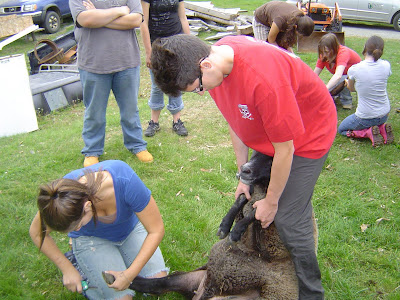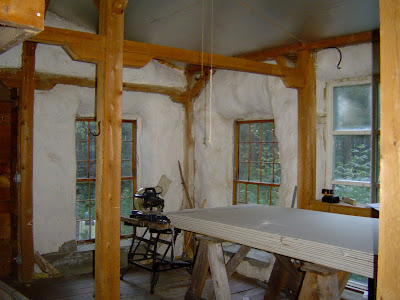

Students from the introductory class in captive wildlife care came to the farm Monday and Wednesday to learn how to handle sheep. These are first years, but they were intelligent and spirited and willing to get stuck in.
Each group got a sheep in need of dung tagging and hoof-trimming. The animals were checked for fly strike and anemia caused by barber pole worms, a nematode parasite. The groups that worked with the new ewe-lambs were able to see, or in one case learn to give, tetanus shots.
We had a few high jinks as students learned to handle animals competently. Animal handling takes practice. You have to move quickly but smoothly, with a good deal of confidence. Each move has to be with full, firm force, no half-measures. This takes a good deal of practice, and your first moves might seem very like the first blasts of a trainee bagpiper, or the first attempts to drive a stick-shift car.
On reflection, I'm reminded that this characteristic might be what makes animal handling training such a good thing for them at this age. Well over eighty percent of the students in this program are female.
Needless to say, this is not the normal kind of movement exhibited by teenage people in public. Students of both sexes at age eighteen, but especially female ones, routinely lack this kind of confidence in their movements and persona. Our society, with its emphasis on appearance and glamor, mitigates against development of other kinds of confidence and agility in young men and women. One of the ways it does this is by assigning them both unfairly them to certain kinds of roles, and by repeatedly providing the message, especially to women, that what matters is always looking good.
As any trainee sheep shearer will tell you, it's not actually possible to look good while learning how to catch, move, and "throw" a 150 pound woolly-minded animal for the first time in your life. You do not have a spare second to consider how your attempts look to any audience you may have. You just have to learn on your feet.
A couple of our class members hesitated a second or lacked the proper confidence or applied less firmness than was called for and their sheep were gone in milliseconds, off to the far corners of the home paddock, not to be caught again that day.
Oops. Oh dear, how sad, never mind. Try again with another one.
Get back on the horse that threw you.
There are lots of other good things that come out of animal handling training. We emphasize the responsibilities of any post involving animal care -- you're the one that has to get up and feed, water, and check your flock, whether it's Monday, Friday or Sunday, Christmas or your birthday, and while that duty can be delegated to a responsible person, you have to be absolutely sure that the person you delegate it to will do it and do it properly.
The animals won't understand if they have to go without clean water or feed or needed medical care for a day because you were derelict in your responsibilities.
We also emphasize the animal carer's role as a scientist. First year students' eyes tend to glaze over in Bio I and II, but once you learn how important it is to know your parasites, or plants, or diseases, and once you realize that biology is foundational to animal medicine, and that animal care is actually applied biology, then you might have a better reason to crack open that fat old biology book and learn some of those Latin names or some of those important cycles of respiration or those pathways of protein synthesis.
So the briefing for the sheep handling training gives us a chance to lay this all on again, and we lay it one pretty thick, with emphasis, because it's such a good teaching moment.
Who knew you could get so much out of learning to move, throw and tend sheep.







